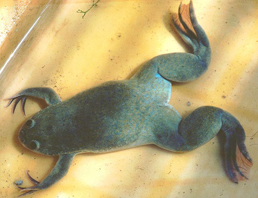Podcast for 11 March 2011: Animal Adaptations
Regional dialects in gibbons, a squid attack pheromone, bats and carnivorous plants, and why frogs are slimy.


Regional dialects in gibbons, a squid attack pheromone, bats and carnivorous plants, and why frogs are slimy.
Mother of pearl gets its strength from the combination of two very different kinds of materials.

ANNUAL MEETING SPECIAL: The new science of aeroecology, deconstructing taste preferences, new ways to store energy, and 3-D printers that could one day produce replacement organs.
A drum-like beat determines whether a baby paper wasp will become a worker or a future queen.
At least one carnivorous plant appears to have lost its taste for insects in favor of bat guano.
The discovery of a female pterodactyl with an egg in China is making paleontologists take a second look at old fossil collections.
ANIMAL STORIES: An Australian bird benefits when its predator sings, what happens when bees get sleepy, the invasion of the giant fish, eating insects to slow global warming, and a female pterodactyl fossil is discovered in China.
Scientists are using DNA to track the invasion of Asian carp in the United States.
Scientists have erased learning and memory deficits in a mouse model of early Alzheimer's disease.
NATURE OF INVENTION: Sea urchin teeth could inspire new nano-materials, and hornet stripes could lead to better solar technology. Also: automatic transmissions could revolutionize electric wheelchairs, and there's new research on the genetics of hair color and male pattern baldness.
Fireflies could help doctors deliver the right dose of heparin to prevent blood clots.
In the Kalahari desert, a gangster-like bird provides protection to other birds, but at a high price.
Sterilized male mosquitoes are part of a grand experiment in biocontrol on Grand Cayman Island.
A toxic plant used in a traditional religious ritual is shaping the evolution of a Mexican cavefish.
Bacterial poison darts, a new approach to cancer research, turning skin into blood, depressing night-lights and the differences between human and Neanderthal brains.
Tigers are highly endangered in the wild and the remains of over one thousand of the big cats have been seized in the past decade.
Boa constrictors are the latest addition to the list of vertebrate species in which parthenogensis, or asexual reproduction, has been documented.
